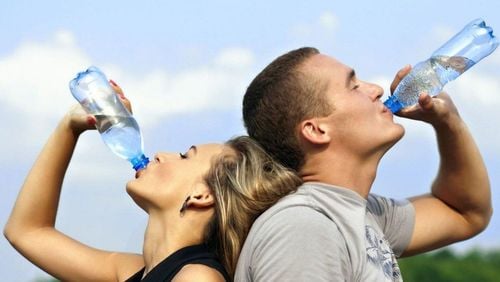This is an automatically translated article.
When people think of endurance, they usually think of endurance. While both are important and related physically and functionally, both terms perform different tasks in the body. So what's the difference between endurance and stamina? Read the article below to understand more.1. The role of endurance and endurance in training
What in muscles helps us increase endurance and stamina? The answer is how our muscles get fuel.Muscles get energy in 4 main steps: The first few seconds use ATP energy stored in cells, then the next few seconds use creatine phosphate stores to supply adenosine triphosphate (ATP). Once it has been used, muscle glycogen stores can be used (a form of energy storage that does not contain oxygen). Finally, aerobic respiration (ATP is made using oxygen) is the final step for the body to supply energy to the muscles.
When we exercise intensely, glycogen is the most precious source of energy. Exercises such as weight training, sprinting, high-intensity cycling, and other anaerobic activities rely on that glycogen store to generate energy for the body to use. Anaerobic exercise is practiced by athletes to increase strength, speed, and build muscle mass.
With these exercises, our body works so hard that the cardiovascular system cannot deliver oxygen to the muscles fast enough. For that reason, anaerobic exercise can only be short-lived at a time or in cases where the body has large reserves of glycogen to use as energy. The problem occurs when that fuel supply is depleted and not replenished.
Glucose in the blood is stored as glycogen in the muscles. Glycogen is the preferred fuel for muscle function during intense or anaerobic exercise. Glycogen is a chain of glucose molecules that the muscles and liver use to store energy. As mentioned earlier, muscles need glucose to make energy (ATP) to stay active. However, exercise causes inflammation of the muscle membranes, disrupting the supply of glucose to the muscles to replenish the used glycogen. In skeletal muscle, the binding of insulin to the insulin receptor allows glucose to enter muscle cells. When glucose enters the cell, it can be converted to ATP and used for energy or stored as glycogen for later. Unfortunately, inflammation reduces the sensitivity of the insulin receptor on muscle membranes, and if that receptor is not activated, glucose cannot move into cells and energy cannot be delivered to the muscle. Therefore, endurance products should consider reducing muscle inflammation and replenishing glycogen stores when designing formulations.
Today's dietary supplements are ideal supplements for improving endurance athletes as it addresses all of these concerns. They are a blend of Panax notoginseng and Rosa roxburghii extracts that are highly purified and fractionated using proprietary pharmaceutical processing and extraction technology. Studies have found that it reduces muscle inflammation, makes it easier for glucose to enter the muscles, and replenishes glycogen stores for use. Supplements can reduce inflammation on muscle membranes, where insulin receptors and glucose transporters are located, to increase insulin receptor sensitivity so that glucose inflow is not interrupted. In addition, these supplements may work to provide muscles with more energy and reduce inflammation caused by intense exercise.

Các loại thực phẩm bổ sung có thể làm giảm viêm trên màng cơ
2. What's the difference between stamina and endurance?
While endurance is defined as the amount of time a given muscle group can perform at or near maximum capacity, endurance is defined as the maximum amount of time a given muscle group can perform a certain action. Another difference includes the idea that endurance is the body's ability to process and deliver oxygen, while endurance is the body's ability to process and provide energy.Weight training exercises typically focus on three related muscle attributes: strength, endurance, and endurance. While they are all related, they are separate concepts related to the physical abilities of each of us.
The concept of muscle strength seems confusing but is actually quite simple. It is the maximum amount of mass that a certain muscle or muscle group can withstand. Strength-targeted exercises focus on increasing the amount of mass a muscle group can lift in one go. For example, an Olympic weightlifter is a strength-based athlete, and a single max lift is the focus of his or her sport.
With regard to strength, endurance is best understood as the amount of time a certain muscle or muscle group can perform an exercise at maximum capacity. If a person is able to do 60-second crunches, he or she is considered to have better abs endurance than someone who can only do 50-second sit-ups. An example of an athlete who may benefit from increased endurance is a sprinter, who must run at full speed for an extended period of time.
Unlike strength, but like endurance, endurance is related to time. While endurance is defined as the amount of time a given muscle group can perform at or near maximum capacity, endurance is defined as the maximum amount of time a given muscle group can perform a certain action. Thus, the distinction between endurance and endurance is a focus — while endurance is limited to performing at maximum power, the focus of endurance is maximizing time regardless of ability. function performed by a given muscle group. For example, while a sprinter might focus on fitness and run as fast as possible for a given distance, a long-distance runner might be more concerned with endurance: he We run as far as we can with speed being a secondary concern.
Endurance training has significant cardiovascular health benefits compared to endurance or strength. While both increase the body's maximum capacity to absorb oxygen, the increase from strength training will be less. In addition, although endurance training leads to a decrease in resting heart rate as well as systolic and diastolic blood pressure, endurance training has little effect on them. Both can be incorporated into diabetes prevention and treatment programs, and both can be used to help boost metabolism and aid weight loss.
While strength training exercises can offer quite a few benefits, a sharp rise in blood pressure following repetitive exercises can be dangerous for people with cardiovascular disease. Therefore, athletes should consult their doctor before adopting strength or endurance training exercises.
3. How to increase endurance and stamina
We can completely improve our endurance and endurance by regularly performing aerobic exercises to improve lung and heart health.3.1. Adhere to the principle of “Specific Adaptation to Needs (SAID)”
One of the fundamental components of building an effective exercise program is the SAID principle. SAID is an acronym for Specific Adaptation to Needs. That means our body will adapt to the particular type of exercise it regularly performs. Example: If we build an exercise program that mainly includes upper body exercises, our upper body strength will improve but lower body strength will not change.3.2. Principle of overloading
Another fundamental concept for building an effective exercise program is the overload principle. This principle involves gradually increasing volume or intensity to further improve the fitness of the practitioner.For example, if a person wants to improve their running time over a distance of about 5 km, they will need to gradually make their exercises harder by increasing:
Running distance Running speed Running time running time.
3.3. Set a weekly exercise goal
Regular exercise can help boost energy levels by helping people sleep better and increasing blood flow throughout the body. The American Heart Association recommends at least 150 minutes of aerobic exercise per week to help strengthen our hearts and lungs. People who spend more than 300 minutes a week exercising can get even more health benefits.3.4. Yoga or meditation
Stress-relieving activities in our weekly routine can help with relaxation and improve our ability to handle more intense exercise. Two examples of relaxing activities include yoga and meditation. A 2016 study found that medical students who underwent six weeks of yoga and meditation experienced significant improvements in feelings of relaxation, focus, and endurance.
Yoga giúp tăng sức bền cho người tập
3.5. Determine target heart rate
Each person's aerobic fitness target heart rate should be 50 to 70 percent of their maximum for moderate-intensity activities and 70 to 85 percent of their maximum for vigorous activity. .We can estimate our maximum heart rate by subtracting age by 220. For example, if you are 45 years old, your maximum heart rate will be 175.
3.6. Try high-intensity interval training
High Intensity Interval Training (HIIT) consists of repetitive bursts of high-intensity exercise with periods of rest. An example is a 10-second sprint exercise with a 30-second rest between each sprint.Along with improving heart health, high-intensity interval training can improve insulin sensitivity, blood pressure, and help exercisers lose belly fat. High-intensity interval training is an advanced form of exercise and is best suited for people who are already physically active.
3.7. Practice exercises according to your interests
Many people think of exercise and immediately think of exercises like lifting weights and running on the treadmill. However, even if you don't enjoy these activities, there are plenty of ways to improve your fitness. Instead of forcing yourself to do an exercise you don't enjoy, think of activities that make you feel more enjoyable. For example, if you hate running but love dancing, taking a dance class like Zumba is a great way to improve your fitness.3.8. Always keep enough water for the body
To prevent dehydration during exercise, it's important to stay hydrated, especially when exercising in hot or humid conditions. During extended training sessions, athletes may consider using electrolytes to replenish minerals lost during sweating.The terms "endurance" and "endurance" have similar meanings and are often used interchangeably. Regular aerobic exercise can help us raise both of these important metrics. Experts recommend doing at least 150 minutes of aerobic exercise per week. In addition, increasing the duration and intensity of exercise can also bring greater health benefits.
Please follow the website ( www.vinmec.com ) for more information on health care instructions, which we will update regularly.
Please dial HOTLINE for more information or register for an appointment HERE. Download MyVinmec app to make appointments faster and to manage your bookings easily.
Reference sources: healthline.com, livestrong.com, nulivscience.com












